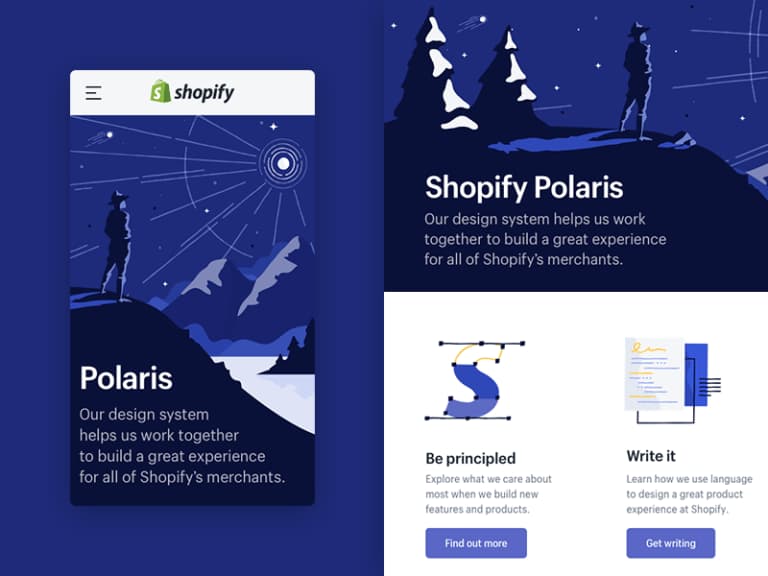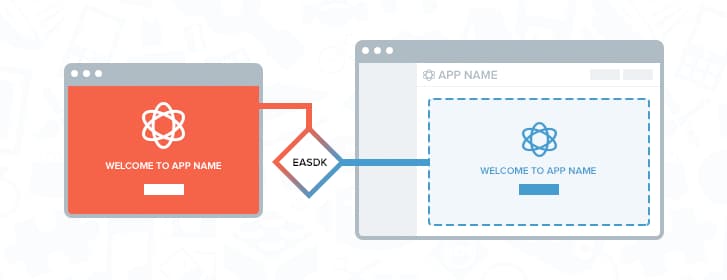Shopify is the fastest-growing and most popular e-commerce platform. It is built and has convenient tools in Ruby on Rails. There is no doubt that today, Shopify hosts hundreds of apps covering a wide area of interest in order to fulfill store owners’ needs.
Polaris

On April 20, 2017, Shopify released Polaris, a new design system. Polaris is a React component library designed to help developers offer the best experience for merchants who use Shopify to run their stores. We are talking about a huge step that aims to provide a consistent user experience for store owners, removing completely the idea of having your own theme on your apps. Visit the Polaris style guide to learn more.
Current Situation
Today we could categorize the apps in the Shopify store in two different categories based on the way they load. So we have the embedded apps that load inside the Shopify admin page and the non-embedded apps that load outside the Shopify system. At the same time, we could separate them also based on the user interface they have, so we have the polaris-based apps that use Polaris or inherit the Shopify stylesheet for their theming and the non-polaris-based apps that use their own branding theme.
As Shopify mentions in the help articles, you can use embedded app libraries to extend the reach of your app and create seamless user experiences for merchants in Shopify. By default, all newly created apps have the Embed in Shopify admin app extension enabled. This means that your app will load inside of Shopify admin. If you’re building an embedded app, then you must use the Embedded App SDK. Of course, the vast majority of existing apps are non-embedded.
There are companies that provide some apps in multiple platforms, apart from Shopify, so they provide one system as the frontend and on the backend, they communicate with the different APIs. In this way, they support one platform rather than multiple. Also, there are companies that provide apps with a lot of functionality and multiple menus or long pages with forms and other information that is very difficult to make happen with an embedded app. In other words, there are pros and cons to both approaches.
Only embedded apps on Shopify from now on?
Shopify is not making any comment on that but we think that in the near future this will be one way because it will make store owner work better and easier forgetting that he switches between his main store backend and the backend of the different app.

Transform your existing non-embedded to an embedded app
Apart from the things that we just mentioned in the previous section, there are a lot more reasons that you need to do this soon. Of course, we are not talking about a trivial task, but it will become a need sooner or later if developers want to follow the Shopify route. Apps that provide a wide range of functionality or have a lot of options in their user interface (ex. long menus, long forms, etc) will take more time to be transformed. In more detail, these apps will be needed to be redesigned in order to be able to provide the same functionality in a smaller available area covering all the requirements and limitations of an iframe app. In addition to that, existing store owners that are using these apps should be informed and supported to switch to the new look and feel of their apps because sure they will meet some difficulties in the beginning.

But let’s think further and clearly, any software needs to be updated and this is the right time to be done for these apps as well. We think that this is the future and this is the way we should approach the Shopify apps from now on. At the end of the day, the merchants are the ones who want to do things easily, fast, and without having to care about backend tasks, procedures, and problems. Most of them are not computer experts and they just know the basics of using a browser, so it’s important for them to have one environment with the same experience and feedback.
From a competitor’s point of view, we all need to see this as an opportunity to get improved and provide our solutions in a simpler way. And don’t forget that anytime new store owners will come and these people need to find you easily and understand your app even without reading any document or help article. How easy is your existing or new app, and the easier it will be for new clients to install and pay for your app? Simplicity is the top priority in the Shopify community.
In conclusion
In this post, we have gone over the embedded and non-embedded app options on Shopify, comparing the two options. Although we covered a lot, there’s still plenty more that you can read about that topic and many updates from Shopify that you can discover on your own. Now that you have a better idea, you can work with your team making your work even better. Happy coding!




